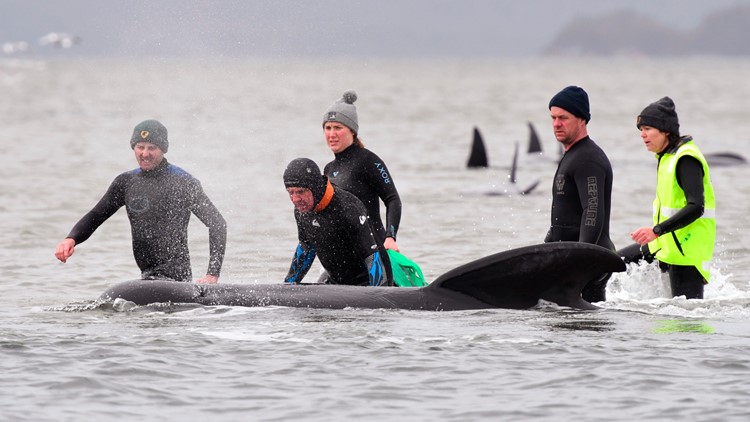The deaths of nearly 400 pilot whales on the shore of Tasmania's west coast has captured global attention, both for the rescue efforts from local agencies and for the puzzling cause behind such a tragic event.
Images captured by helicopters paint the stunning scene, as the bodies of the hundreds of massive sea creatures lay in the shallow waters of the Macquarie Harbor.
According to authorities, 70 beached whales were rescued by locals and staff members from the Tasmania Parks and Wildlife Service. Marine and Conservation Program wildlife biologist Dr. Kris Carlyon said the stranding was the largest in Tasmania history, according to Storyful.
"Globally, there has been some much bigger events than this, twice the size and over, for example, in New Zealand. In Tasmania, this is the biggest we have recorded," Dr. Carlyon said in a statement from the Department of Primary Industries, Parks, Water and Environment. "There is little we can do to prevent this occurring in the future."
While the exact reason for why beachings occur is uncertain, experts have a variety of theories. Some have speculated that the whales' navigation and false echoes can bring them into shallow waters, as Carlyon said the "misadventure" of a couple whales could lead many others astray.
Another theory that has been researched from years involves weather patterns that could throw off the marine animals' navigational abilities. But those weather patterns aren't Earth-bound, like a hurricane or a change in the winds, but rather possibly millions of miles away on the surface of the sun.


In recent years, researchers from NASA provided several theories on why space weather conditions may result in healthy whales, dolphins and porpoises, collectively known as cetaceans, washing ashore.
"Theories as to the cause include magnetic anomalies and meteorological events, such as extreme tides during a new moon and coastal storms, which are thought to disorient the animals," said Antti Pulkkinen, a NASA heliophysicist who co-authored a study on the topic. "It has been speculated that due to the possible magnetic-field sensing used by these animals to navigate, magnetic anomalies could be at least partially responsible."
AccuWeather Meteorologist and astronomy blogger Brian Lada said there has been a recent uptick in solar activity, which peaked on Sept. 21, the same day the whales beached.
"The sun has been showing some signs of life in recent weeks as it transitions from a period of low activity, called the solar minimum, to a period of high activity, called the solar maximum," Lada said. "This was far from what would be observed during a major solar storm, and it is unclear if it is related to the beached whales, but given the timing, it can't be completely ruled out as a factor in the whales' behaviors."
According to Lada, one way scientists track solar activity is with X-rays. An instrument on NOAA's GOES-16 weather satellite is equipped with a sensor to track X-ray emissions from the sun. The solar cycle lasts 11 years, with sunspot activity waxing and waning over that cycle.
Earlier this year, The New York Times reported that researchers recognized a correlation between whale strandings and sunspot data, noting that when there were more sunspots on the surface of the sun, gray whales were more likely to get stranded on beaches.
While still just a theory, the authors of a study published in the Cambridge University Press titled "Solar storms may trigger sperm whale strandings: explanation approaches for multiple strandings in the North Sea in 2016" speculated that solar activity could alter whales' magnetic sense of direction.
"Mass strandings of whales have often been documented, but their causes and underlying mechanisms remain unclear. We investigated the possible reasons for this phenomenon based on a series of strandings of 29 male, mostly bachelor, sperm whales (Physeter macrocephalus) in the southern North Sea in early 2016," read the study's abstract. "Whales' magnetic sense may play an important role in orientation and migration, and strandings may thus be triggered by geomagnetic storms."



